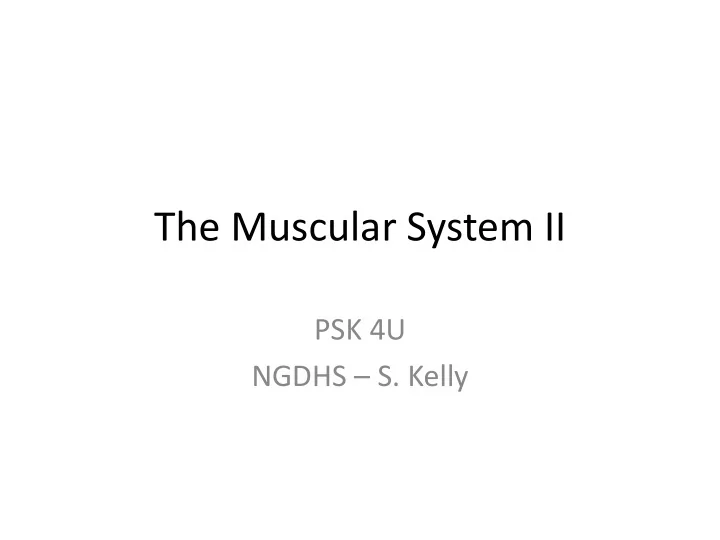

The Muscular System II PSK 4U NGDHS – S. Kelly
The Neuromuscular System • Simply put: the system in which our brain tells our muscles what to do • Incorporates brain, spinal cord, nerves, muscles • Both the nervous system and the neuromuscular system can be improved and refined with training • Training involves (among other things) consistent use and practice
The Neuromuscular Junction • Contact point between nerves and muscles in these simplified steps: 1. Electrical impulse travels along the nerve pathway 2. At the junction, neurotransmitter chemical acetylcholine (ACh) is released 3. ACh detected by receptors on muscle fiber and contraction occurs 4. Next slide: events 1-7 are labeled in order of occurrence (steps 1-3 above are a simplification…)
Neuromuscular Junction
Motor Units • Twitch: wave transmission of nervous impulse (ensures smooth movement) and the associated contraction • Motor Unit: motor neuron + axon + all muscle fibers it stimulates • Small vs. large motor units: basically few muscle fibers and/or fine motor movement vs. many muscle fibers and/or gross motor movements
All Or None Law • When a motor unit is stimulated by a nervous impulse, it will do so to its fullest potential • Stimulus must exceed threshold potential for muscle contraction and when it does: • Either ALL of the fibers in a motor unit will contract or NONE will contract
Excitation-Contraction Coupling • Conversion of chemical energy to mechanical energy • Transverse tubulae system: network of connected rings surrounding each myofibril, links myosin/actin to outside of muscle • Change in electrical properties of tubulae causes release of Ca ions
The Role of Calcium • Trigger mechanism for excitation-contraction coupling • Ca released into sarcoplasm • Without Ca, actin and myosin do not interact with each other • Calcium interacts with troponin and tropomyosin to allow myosin and actin to interact and coupling then occurs, muscle contracts
Sliding Filament Theory • Theory from mid-1950s, still widely accepted • Actin and myosin filaments overlap and sarcomere shortens • “ Crossbridges ” from myosin (thick) to actin (thin) attach, rotate, detatch, reattach in rapid succession • Re-uptake of calcium causes muscle relaxation, process requires ATP as fuel • ATP also required to detach myosin and actin from one another
Sliding Filament Theory
Some Additional Resources
What’s Next? • Lesson: Neuromuscular Adaptation to Training • Anatomy quiz Thursday
Recommend
More recommend